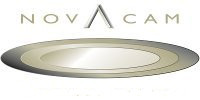Advantages of NOVACAMTM fiber-based LCI technology
Unique design
NOVACAM 3D metrology systems offer many advantages to our clients thanks to a unique combination of:
- Low-coherence interferometry (LCI) technology
- Modular, fiber-based design, meaning that the optical probe that scans the measured part is connected to the signal-processing detector (low-coherence interferometer) with an optical fiber
- A selection of non-contact optical probes to satisfy most metrology applications – standard, small-diameter (down to 0.5 mm diameter), long (as long as 2 m has been built), rotational, and galvo (raster) scanning probes
Advantages
Advantages of NOVACAM 3D metrology systems include:
- Micron measurement precision
- Non-contact measurements – optical probes measure without affecting measured surfaces the way that a contact probe can affect them
- Very high scanning speeds – up to 100,000 3D-point measurements per second
- Ability – with the same system – to measure
- 3D geometry (GD&T parameters),
- thickness,
- roughness,
- chatter, and/or
- defects
- Ability to measure hard to reach surfaces, such as the insides of small-diameter tubes and bore holes, with thin probes that can reach inside such spaces
- Ability to measure surfaces with high-aspect-ratio features, such as steps, grooves, EDM slots, channels, holes and steep slopes. We use collinear scanning, meaning the emitted and reflected light signals travel along the same axis, enabling measurement of high-aspect-ratio features that technologies relying on triangulation cannot reach.
- Ability to acquire long profiles. The probes acquire 3D data one point at a time, at high scanning speeds (see above). As such, they can continuously measure material on production line webs. Typically, there is no need for time-consuming surface tiling.
- Ability to perform in hostile environments: Probes can measure in radioactive, cryogenic, or very hot environments, vacuum or evaporation chambers, through glass or sapphire windows, standoff distance of up to 1 m, measurements in water.
- Support for in-process automation and deployment. The fiber-based modular design of the system brings many advantages: while the fiber-based probes (mounted on either online or bench-top fixtures) operate next to the measured surface, optical signals travel to/from system interferometer via an optical fiber. As such, the probes are easily integrated with robots as well as as any application-specific benchtop or inline motion mechanism. A standoff distance (from probe tip to sample surface) of up to 1 m is also possible. Measurement recipes for various types of components can be easily defined and then recalled with the press of a button or selected from a list.
- Knowledge of the absolute distance of the sample surface when the instrument is turned on (without counting fringes)
- Resistance to air perturbation, ambient lighting and to cutting the beam
- Ability to multiplex several probes/scanners to the same interferometer, enabling the scanning of a variety of parts with various types of probes with the purchase of only one interferometer. This capability provides additional return on investment (ROI) for many of our clients.
- Operational savings thanks to no need for consumables – non-contact probes do not wear
- Ability to measure a wide range of materials: metal, plastics, polymers, glass, metal coatings, silicone, adhesives; reflective, transparent, semi-transparent, specular, nonspecular. Dull or shiny surfaces may be measured regardless of color or material. No powder coating necessary to obtain reliable scan data.
- Option of custom-manufactured probes with angled light beams that measure undercuts, blind hole corners, O-ring groove walls, etc.
- NOVACAM 3D metrology systems are more than just sensors; they are typically turnkey solutions where the sensor is integrated with motion axes.
Related links
Learn more about:
- How low-coherence interferometry (LCI) works
- What all we can measure with LCI technology
See NOVACAM 3D metrology systems based on LCI
Contact us or request free sample analysis to see if our 3D metrology systems are suitable for your application
